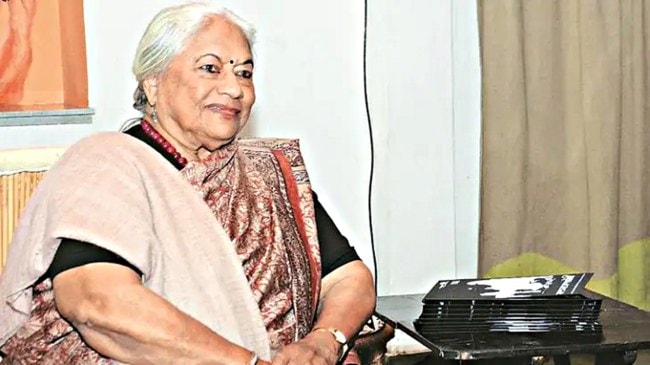Opinion Prerana Shrimali writes: Kumudini Lakhai, the kathak exponent who loved tradition and breaking past it
As I look back on my journey as a kathak dancer, I can confidently say that if I am considered a thinking dancer today, the credit for it goes to Kumudini ji.
 Kathak dancer Kumudini Lakhia was an artist beyond gharanas or the specific schools of kathak. (Source: File)
Kathak dancer Kumudini Lakhia was an artist beyond gharanas or the specific schools of kathak. (Source: File) Written by Prerana Shrimali
“Abhinaya Darpan ka pehla shlok kya hai? (“What is the first shloka of Abhinaya Darpan,” Kathak exponent Kumudini Lakhia had asked me in an interview for a specialisation course in performance at New Delhi’s Kathak Kendra after I came first in my diploma course.
Abhinaya Darpan is a Sanskrit treatise that defines the grammar and technique in dance and is significant in understanding gestures and expression.
I told her I knew the meaning.
She asked me again and I gave the same answer.
She raised her voice then and said, “I am asking for the words, can’t you hear that?”
“Nobody is teaching that here,” and I broke down.
But with this one question, Lakhia gave me the lesson of my life. It was for the first time I understood that Kathak is not only a dance — it’s way beyond that. And it’s from that day that my journey as a dancer took a different path.
Kumudini didi (as we used to call her) was an artist beyond gharanas or the specific schools of kathak. She pushed the boundaries of tradition to accommodate her own narrative. “If kathak is ‘katha’ then why not my own katha?” she’d ask. “Why only repeat what is already said a 100 times? I want to speak my mind, ask my queries, and turn problems of life into themes.” And she boldly did that.
Once in conversation with the senior critic Shanta Sarabjeet Singh, she said, “I only know Kathak. Whatever I do, becomes kathak”. She was talking about her challenges with the vocabulary of kathak. It is this introspection to find her expression that led her to so many firsts. She was the first one to change the face of group choreography in Kathak. She used just “nritta” or abstraction to tell the whole story. She introduced an entirely new form and colours to the Kathak costume, ones that were more earthy and belonged to reality, not just the bright colours that the gods wore. She dropped the dupattas from many of her costume designs at a time when it was not just an integral part of the costume but also implied virtue. These were all revolutionary changes. Then there are her choreographic patterns — a solo dancer covering the whole stage and using padhant (recitation of Kathak syllables) as narrative itself — have now become an inevitable part of Kathak choreographies all over the world.
I had the opportunity to work with her on a couple of her choreographies and I noticed that she was firmly rooted in tradition. But tradition can also push boundaries.
Her first major choreography was “Dhabkar” (Pulse). I was part of it for the concluding show at the Festival of India, UK in the year 1982. This was followed by Atah Kim, Samanvay and Bhav Krida among others. She also composed a duet called “Yugal” with her senior-most disciples Daksha Sheth and Arjun Mishra, which, I believe, was the first ever duet that spoke about the male and female energies with just the bodies, sans any expressions. She’d say, “I want the body should speak, no facial expressions”. All of these things make her a pioneer in Kathak.
Her learning started with Sohanlal ji of Bikaner, followed by Ashiq Hussain of Banares gharana and the great Pt Sunder Prasad of the Jaipur gharana. After that, she studied under Pt Shambhu Maharaj of the Lucknow gharana. After learning in such traditional spaces, she broke all barriers. It is due to her intellectual depth that she came out as an artiste who never needed any label of any school or gharana. She created a style which is now known as Kumiben’s style.
Once, I was taking a workshop in Kadamb (her institution in Ahmedabad) and she showed me a few of the traditional compositions and, simultaneously, the version she had created through her vocabulary of movements. I was mesmerised.
For someone who started her classes in Ahmedabad in a small garage at a time when Kathak was new there, and Mrinalini Sarabhai’s institution was the only primary place to learn dance, she worked tirelessly to push herself and, in turn, Kathak into the lives of people. Her institution, Kadamb, is now one of the premier institutions to learn the artform.
Today, when she is not in this world, I remember her with so much gratitude. As I look back on my journey as a Kathak dancer, I can confidently say that if I am considered a thinking dancer today, the credit for it goes to Kumudini ji, and how she made me cry at Kathak Kendra.
I still remember how once she was explaining the specific nuances of going to the temple, and one come across the “panch tatva” (five elements) and five senses — from touching the floor to the fragrance to the air to jal (water), and deepak (light). Today, she is merged in the panch tatva but her creative fragrance will always remain in our hearts. I bow down to her memory. Rest in peace. I will never forget you.
Shrimali is a senior dancer of the Jaipur gharana of Kathak





